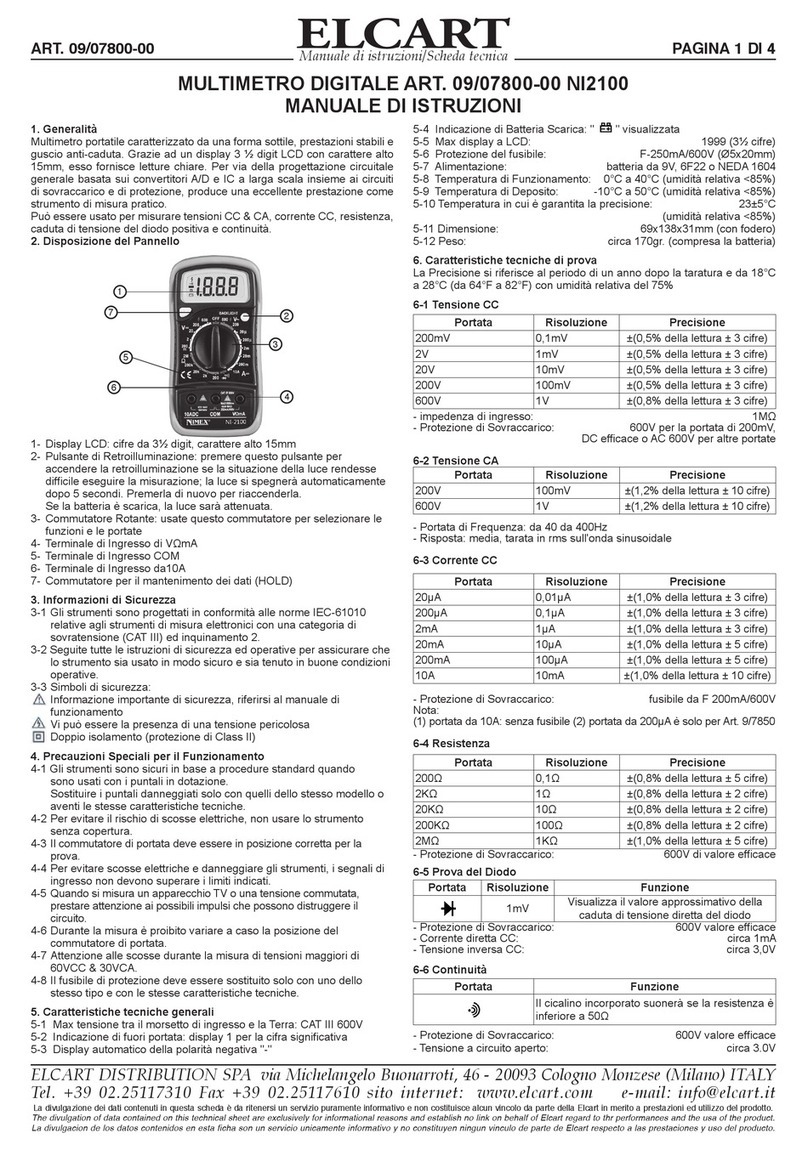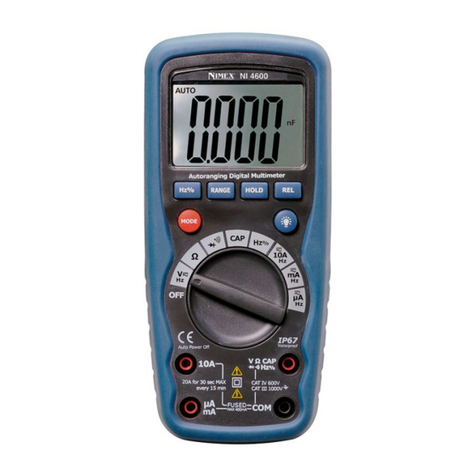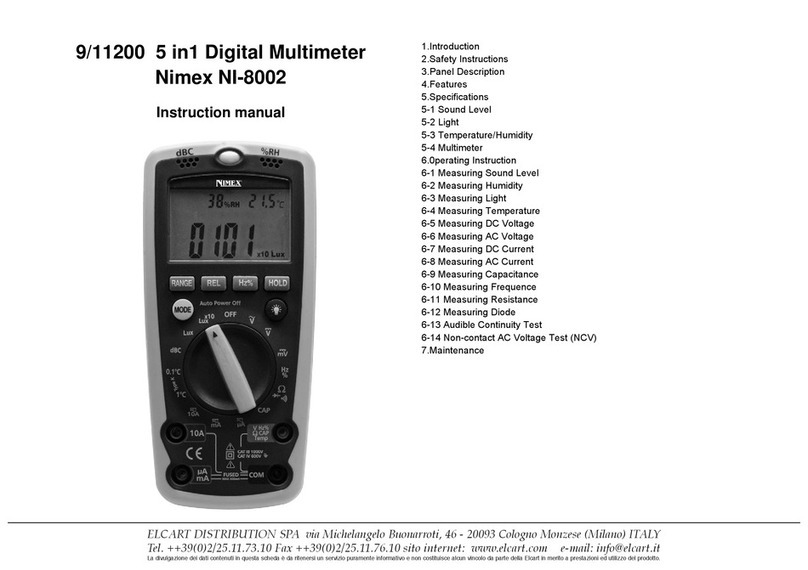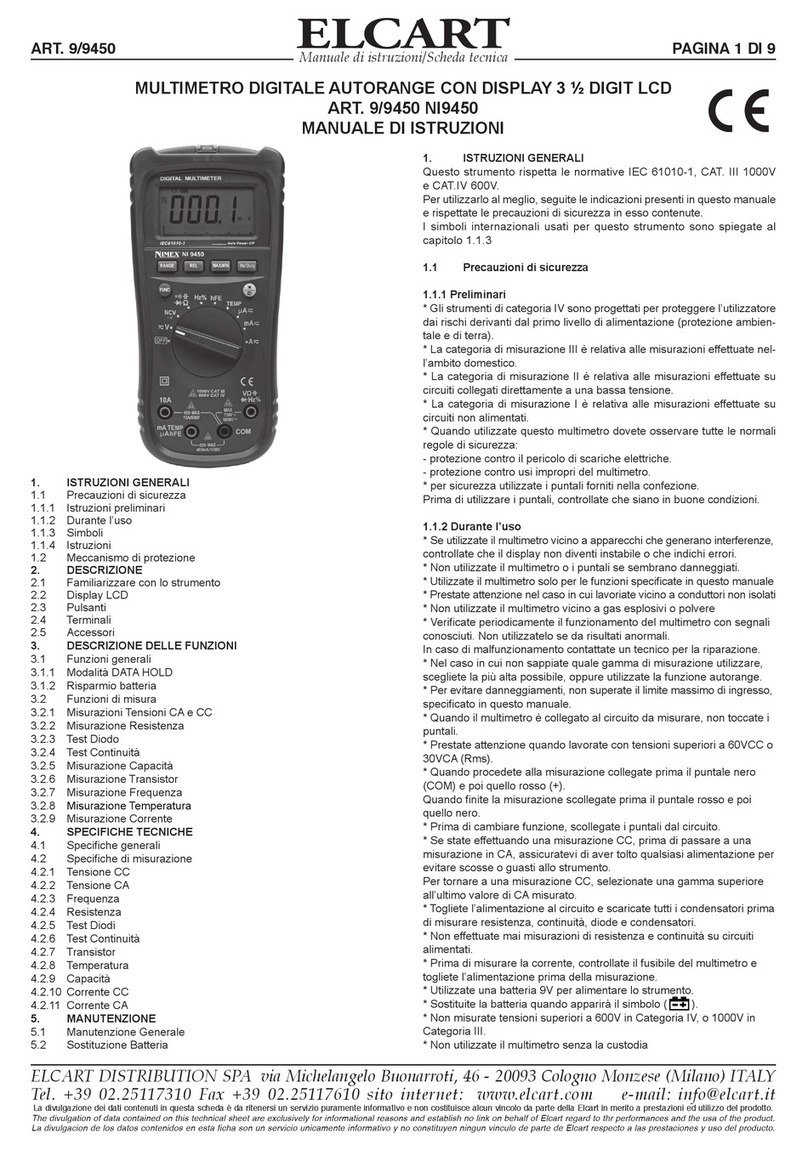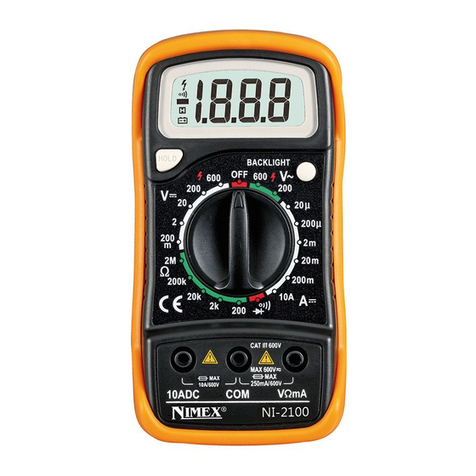
ELCART
ELCART DISTRIBUTION SPA via Michelangelo Buonarroti, 46 - 20093 Cologno Monzese (Milano) ITALY
T
el.
+39
02.251
17310
Fax
+39
02.251
17610
sito
internet:
www
.elcart.com
e-mail:
[email protected]Manuale di istruzioni/Scheda tecnica
La divulgazione dei dati contenuti in questa scheda è da ritenersi un servizio puramente informativo e non costituisce alcun vincolo da parte della Elcart in merito a prestazioni ed utilizzo del prodotto.
The divulgation of data contained on this technical sheet are exclusively for informational reasons and establish no link on behalf of Elcart regard to thr performances and the usa of the product.
La divulgacion de los datos contenidos en esta ficha son un servicio unicamente informativo y no constituyen ningun vinculo de parte de Elcart respecto a las prestaciones y uso del producto.
ART. 09/07850-00 PAGINA 2 DI 4
7. ISTRUZIONI OPERATIVE
7-1 Precauzioni da seguire prima del funzionamento
7-1-1 Controllare la batteria da 9V. Se la tensione della batteria è
inferiore a 7V, il display mostrerà " ", a questo punto la batteria
deve essere cambiata per garantire la precisione della misura.
7-1-2 Porre attenzione al segno " " posto accanto al terminale di
ingresso, che indica che la tensione o corrente di ingresso non
deve superare il valore specicato.
7-1-3 Il commutatore di portata deve essere posto alla portata prescelta
per la misura prima del funzionamento.
7-2 Misurare la Tensione VCC
7-2-1 Inserire il puntale nero nel terminale "COM" e quello rosso nel
terminale "VΩmA".
7-2-2 Porre il commutatore rotante alla posizione di portata desiderata V
7-2-3 Collegare i puntali all'apparecchiatura da misurare.
7-2-4 La lettura viene visualizzata sul display LCD.
La polarità del collegamento del puntale rosso sarà indicata
insieme al valore della tensione.
NOTA:
1. Quando non si conosce prima la scala di misura, porre il selettore di
portata nella posizione più alta.
2. Quando è visualizzata solo la cifra "1" o "-1", ciò indica una situazione
di fuori-portata e deve essere selezionata la portata più alta.
3. " " indica che non si può porre la tensione di ingresso superiore a
600V, è possibile indicare una tensione più alta, ma può distruggere il
circuito interno o provocare una scossa.
4. Attenti alle scosse quando si misura un'alta Tensione.
7-3 Misurare la Tensione VCA
7-3-1 Inserire il puntale nero nel terminale "COM" e quello rosso nel
terminale "VΩmA".
7-3-2 Porre il commutatore rotante nella posizione di portata desiderata V~
7-3-3 Collegare i puntali all'apparecchiatura da misurare.
7-3-4 La lettura viene visualizzata sul display LCD.
NOTA:
1. Quando non si conosce prima la scala di misura, porre il selettore di
portata nella posizione più alta.
2. Quando è visualizzata solo la cifra "1" o "-1", ciò indica una situazione
di fuori-portata e deve essere selezionata la portata più alta.
3. " " indica che non si può porre la tensione di ingresso superiore a
600V, è possibile indicare una tensione più alta, ma può distruggere il
circuito interno o provocare una scossa.
4. Attenti alle scosse quando si misura un'alta Tensione.
7-4 Misurare Corrente CC
7-4-1 Inserire il puntale nero nel terminale "COM" e quello rosso nel
terminale "VΩmA" per una corrente massima di 200mA,
oppure nel terminale "10A" per una corrente massima di 10A.
7-4-2 Porre il commutatore rotante alla posizione di portata desiderata A
7-4-3 Interrompete il circuito collegando in serie i puntali.
7-4-4 La lettura viene visualizzata sul display LCD.
La polarità del collegamento del puntale rosso sarà indicata insieme
al valore di corrente.
NOTA:
1. Quando non si conosce prima la scala di misura, porre il selettore di
portata nella posizione più alta.
2. Quando è visualizzata solo la cifra "1" o "-1", ciò indica una situazione
di fuori-portata e deve essere selezionata la portata più alta.
3. " " indica la corrente massima della presa (200mA e 10A), per cui la
sovracorrente distruggerà il fusibile.
Dato che 10A non è dotata di fusibile, il tempo di misura deve essere
inferiore ad 1 secondo per evitare che la precisione venga influenzata
dal riscaldamento del circuito.
7-5 Misurare la Resistenza
7-5-1 Inserire il puntale nero nel terminale "COM" e quello rosso nel
terminale "VΩmA".
7-5-2 Porre il commutatore rotante sulla posizione di portata Ω desiderata.
7-5-3 Collegare i puntali all'apparecchiatura da misurare
7-5-4 La lettura viene visualizzata sul display LCD.
NOTA:
1. Quando è visualizzata solo la cifra "1" o "-1", ciò indica una situazione
di fuori-portata e si deve selezionare la portata più alta.
2. Per misurare una resistenza superiore a 1MΩ, lo strumento può
impiegare alcuni secondi per dare una lettura stabile.
3. Quando l'ingresso non è collegato, ad es. a circuito aperto, la cifra "1"
sarà visualizzata per la condizione di sovraportata.
4. Quando si controlla la resistenza interna del circuito, assicurarsi che
tutta l'alimentazione sia esclusa dal circuito sotto prova e che tutti i
condensatori siano stati completamente scaricati.
5. Se la scala del valore da misurare non si conosce prima, porre il
selettore di portata nella posizione più alta.
7-6 Misurazione Temperatura
7-6-1 Posizionare il selettore rotante nella posizione °C.
7-6-2 Il display LCD visualizzerà la temperatura ambientale del momento.
7-6-3 Connettere il puntale rosso della termocoppia di tipo "K" nella presa
"VΩmA" e il puntale nero nella termocoppia di tipo "K" nella presa
COM.
7-6-4 Leggete il valore di temperatura sul display LCD.
7-7 Prova del Diodo
7-7-1 Inserire il puntale nero nel terminale "COM" e quello rosso nel
terminale "VΩmA", (la polarità del terminale rosso è "+")
7-7-2 Porre il commutatore rotante nella posizione di portata .
7-7-3 Collegare il puntale rosso all'anodo e quello nero al catodo del
diodo sotto misura.
7-7-4 La lettura viene visualizzata sul display LCD.
NOTA:
1. Lo strumento indicherà il valore approssimativo della caduta di
tensione diretta del diodo.
2. Se il collegamento al terminale è invertito, sarà visualizzato solo "1".
7-8 Prova di Continuità
7-8-1 Inserire il puntale nero nel terminale "COM" e quello rosso nel
terminale "VΩmA".
7-8-2 Porre il commutatore rotante nella posizione di portata .
7-8-3 Collegare i puntali tra due punti del circuito sotto prova.
7-8-4 Se vi è continutià (ad es. resistenza inferiore a 50Ω), suonerà il
cicalino incorporato.
NOTA:
Nel caso di circuito di ingresso aperto, sarà visualizzata la cifra "1".
8. Manutenzione
8-1 Prima di cercare di togliere lo sportello delle batterie o di aprire la
custodia, assicurarsi che i puntali siano stati scollegati dal circuito di
misura per evitare il rischio di scosse elettriche.
8-2 Per evitare scosse elettriche, togliere i puntali dai circuiti di
misura prima di sostituire il fusibile. Per la protezione da incendi,
sostituire i fusibili con quelli di valori specificati: fusibile F-250mA/600V
8-3 Sostituire i puntali se i terminali sono scoperti, ed utilizzare puntali che
abbiano le stesse caratteristiche tecniche di quelli originali.
8-4 Usare solo tessuto umido e piccole quantità di detergente ma non
usare soluzioni chimiche per la pulizia.
8-5 Non usare lo strumento prima che la copertura posteriore sia chiusa
adeguatamente ed avvitata. In caso di qualsiasi anomalia, sospendete
immediatamente ogni operazione ed inviate lo strumento ad un centro
di assistenza.
9. Accessori
(1) Puntali: valori elettrici 1000V 10A
(2) Batteria: 9V, 6FF22 o NEDA 1604
(3) Fusibile: F-250mA/600V
(4) Termocoppia tipo "K"
(5) Manuale dell'Operatore
(6) Custodia antiurto.
Made in China
Informazione agli utenti ex art. 26 D.Lgs. 49/2014
Il simbolo riportato sull’apparecchiatura (Allegato IX D.Lgs. 49/2014)
indica che il riuto deve essere oggetto di “raccolta separata” e che è stato
immesso sul mercato, in Italia, dopo il 31/12/2010. Pertanto, l’utente
dovrà conferire (o far conferire) il riuto ai centri di raccolta dierenziata
predisposti dalle amministrazioni locali, oppure consegnarlo al rivenditore
contro acquisto di una nuova apparecchiatura di tipo equivalente.
L’utente ha dunque un ruolo attivo: la raccolta dierenziata del riuto e le
successive operazioni di trattamento, recupero e smaltimento favoriscono
la produzione di apparecchiature con materiali riciclati e limitano gli eetti
negativi sull’ambiente e sulla salute eventualmente causati da una gestione
impropria del riuto. Nel caso di RAEE di piccolissime dimensioni
(<25 cm), l’utente ha diritto al conferimento gratuito, senza obbligo di
contestuale acquisto, ai distributori al dettaglio la cui supercie di vendita
specializzata eccede i 400 mq.
IMPORTATO E DISTRIBUITO DA
ELCART DISTRIBUTION SPA
Via Michelangelo Buonarroti, 46
20093 COLOGNO MONZESE (MI)
ITALY






